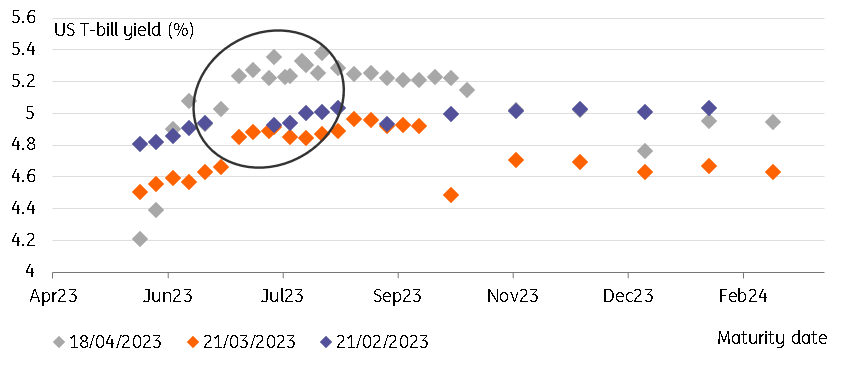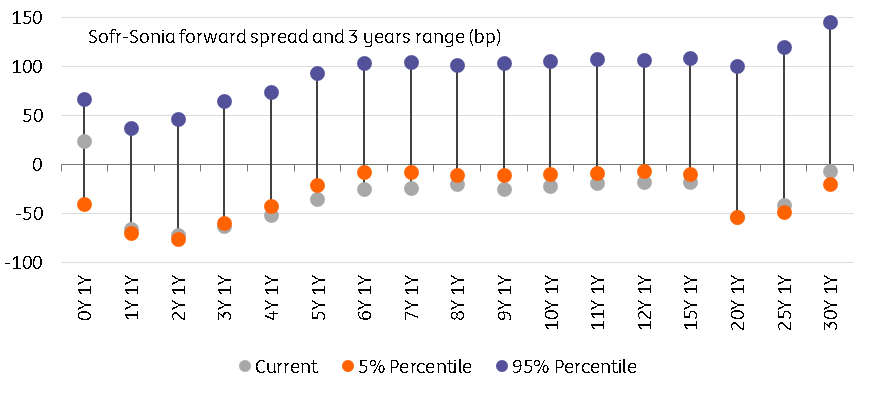US yields are rising across the curve but T-bills are at the intersection of a better economic outlook and a debt ceiling. Sterling rates are now offering a pick-up to dollar equivalents. This makes sense at the front end but less so at longer maturities
US T-bills at the intersection of the debt ceiling-recovery Venn diagram
US T-bills find themselves at the intersection of two uncomfortable developments. First, the longer time passes without any dramatic fall in economic data, the more the fear of a credit crunch fades in investors’ minds. Bank results so far this reporting season have failed to produce a recovery in the KBW US regional banks stock index, but the broader bank stock gauge has shown clearer signs of a rebound. This is probably too early to sound the all-clear but it is also fair to say that bank fears are no longer an impediment to higher front-end rates, and 2Y yields are still around 90bp below their each March peak.
Markets face upwards of $400bn in T-bill issuance, and a commensurate drain of liquidity
The second development is the approaching debt ceiling showdown. There is a clear hump in the T-bill curve around the July-August maturity dates when default risk is deemed most elevated. Information on tax receipts this week may help refine that estimate and so drive relative moves between securities. The fact is that ‘X-date’ is still roughly three months away, so providing a precise estimate at this stage is challenging. The other driver is, of course, political developments, but widespread expectation is for any solution to be found much closer to the deadline this summer.
Once a compromise is found, and it is our expectation that one will be found, T-bills face another challenge: the Treasury ramping up issuance to re-build a cash buffer in the Treasury General Account (TGA). As of last week, its balance was $109bn, but it is likely to go up this week thanks to tax receipts, before going down into the X-date. Assuming the Treasury aims to build its balance back to $500-600bn after the debt ceiling is solved, markets face upwards of $400bn in T-bill issuance, and a commensurate drain of liquidity.
The default probability 'hump' in US T-bill yields is moving forward to June

Source: Refinitiv, ING
Gilts pick-up to Treasuries widens
The re-pricing higher in US yields has been impressive these past two weeks and has widened the spread with euro rates, a development we think will prove short-lived once Fed cuts come into view. The sell-off in sterling bonds however has outpaced that of Treasuries, and that move accelerated with higher than expected wage growth in February. Clearly, the release, combined with core CPI failing to slow in March, increase the odds of a May hike at the Bank of England but market expectations have gone further than that. The Sonia swap curve now prices two more hikes in this cycle, more than what is priced by the dollar curve.
5Y GBP rate in 5Y is higher than its USD equivalent, by almost 30bp
This has taken 10Y gilt yields at a higher than 20bp pick-up to the Treasury curve. Understandably, the pick-up offered by GBP rates is higher at the front-end of the curve. 5Y Sonia swaps are almost 50bp higher than their Sofr equivalent which we justify by the market’s greater conviction that the Fed is about to cut rates later this year. We agree that European policy rates, sterling rates included, will take longer to be cut. We find is harder to justify that longer-dated forward, for instance the 5Y GBP rate in 5Y is higher than its USD equivalent, by almost 30bp.
GBP forward swaps are higher than their USD equivalent at all but one maturities

Source: Refinitiv, ING
Today’s events and market view
European data mostly consist of current account and construction output.
Bond supply will be from Germany (10-Year) and the UK (5-Year).
ECB comments will hit the wires throughout the day with speeches from Philip Lane, Klaas Knot, Pablo Hernandez De Cos, and Isabel Schnabel. Given the mood the market is in, with a re-pricing higher in Fed odds and hotter UK CPI than expected, markets will be more sensitive to hawkish comments. Look for the bear-flattening to continue for the time being.
Disclaimer: This publication has been prepared by ING solely for information purposes irrespective of a particular user's means, financial situation or investment objectives. The information does not constitute investment recommendation, and nor is it investment, legal or tax advice or an offer or solicitation to purchase or sell any financial instrument. Read more
